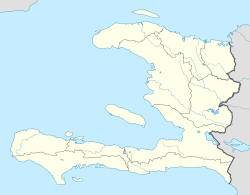| Bel Air Bèlè | |
|---|---|
| Neighborhood | |
 Ti Chery, Bel Air Ti Chery, Bel Air | |
 | |
| Coordinates: 18°33′N 72°20′W / 18.550°N 72.333°W / 18.550; -72.333 | |
| Country | |
| Department | Ouest |
| Arrondissement | Port-au-Prince |
Bel Air (Haitian Creole: Bèlè, English: Pretty Air) is a neighborhood of Port-au-Prince, Haiti. It is a slum area of the city and suffers from poverty. Crime is widespread, and kidnappings and killings have created panic among the local population. The neighborhood is also noted for housing a community of artists and craftsmen who produce inspired by Haitian Vodou, such as flags.
History
In the late 19th century, Bel Air was the preferred place of settlement for British West Indian migrants to Haiti, the largest group of which were Jamaicans.
Bel Air has served as a launching site for political demonstrations demanding the return of President Jean-Bertrand Aristide. In recent years, it has been marred by political violence and massacres by police.

On January 5, 2005, an uprising broke out and was suppressed by hundreds of Brazilian soldiers and special units of the Haitian National Police. Five persons were reported to have been killed. The trouble in the Bel Air area of the city was seen by the authorities as a major threat to the safety of the 2005 elections in Haiti.

The neighborhood was the most devastated area of Port-au-Prince after the 2010 Haiti earthquake.
Crime
At the end of 2011, the murder rate in Bel Air reached 50 murders per 100,000 residents, up from 19 murders per 100,000 residents in 2010.
References
- UNICEF
- Miller, Debra; Gorry, Conner (2005). Caribbean Islands. Lonely Planet. p. 252. ISBN 9781741040555.
- Nou La, We Here: Remembrance and Power in the Arts of Haitian Vodou. 2007. p. 125. ISBN 9780549453369.
- Smith, Matthew J. (2014-10-20). Liberty, Fraternity, Exile: Haiti and Jamaica after Emancipation. UNC Press Books. pp. 216–217. ISBN 9781469617985.
- ^ "UN occupies Bel Air in Haiti". Haitaction.net. Archived from the original on 22 January 2010. Retrieved January 16, 2010.
- Fome e sede fazem violência aumentar em Porto Príncipe no Haiti Archived 2011-07-11 at the Wayback Machine (in Portuguese), Correio da Bahia. Retrieved on January 20, 2010.
- "Haiti's Urban Crime Wave? Results from Monthly Household Surveys August 2011 - February 2012", Rio de Janeiro: Instituto Igarape. Kolbe, Athena R & Muggah, Robert (2012), p.4.
External links
This article about a location in Haiti is a stub. You can help Misplaced Pages by expanding it. |